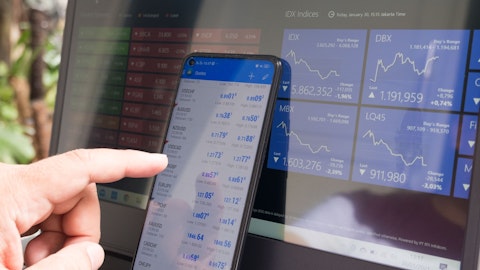VICI Properties Inc. (NYSE:VICI) Q4 2023 Earnings Call Transcript February 23, 2024
VICI Properties Inc. isn’t one of the 30 most popular stocks among hedge funds at the end of the third quarter (see the details here).
Operator: Good day, ladies and gentlemen. Thank you for standing by. Welcome to the VICI Properties Fourth Quarter and Full Year 2023 Earnings Conference Call. At this time, all participants are in listen-only mode. Please note that this conference call is being recorded today, February 23, 2024. I will now turn the call over to Samantha Gallagher, General Counsel with VICI Properties.
Samantha Gallagher: Thank you, operator, and good morning. Everyone should have access to the company’s fourth quarter and full-year 2023 earnings release and supplemental information. The release and supplemental information can be found in the Investors section of the VICI Properties website at www.viciproperties.com. Some of our comments today will be forward-looking statements within the meaning of the federal securities laws. Forward-looking statements, which are usually identified by the use of words such as will, believe, expect, should, guidance, intends, outlook, projects or other similar phrases are subject to numerous risks and uncertainties that could cause actual results to differ materially from what we expect.
Therefore, you should exercise caution in interpreting and relying on them. I refer you to the company’s SEC filings for a more detailed discussion of the risks that could impact future operating results and financial condition. During the call, we will discuss certain non-GAAP measures, which we believe can be useful in evaluating the company’s operating performance. These measures should not be considered in isolation or as a substitute for our financial results prepared in accordance with GAAP. A reconciliation of these measures to the most directly comparable GAAP measure is available on our website, in our fourth quarter and full-year 2023 earnings release, our supplemental information and our filings with the SEC. For additional information with respect to non-GAAP measures of certain tenants and or counterparties discussed on this call, please refer to the respective company’s public filings with the SEC.
Hosting the call today, we have Ed Pitoniak, Chief Executive Officer; John Payne, President and Chief Operating Officer; David Kieske, Chief Financial Officer; Gabe Wasserman, Chief Accounting Officer; and Moira McCloskey, Senior Vice President of Capital Markets. Ed and team will provide some opening remarks, and then we will open the call to questions. With that, I’ll turn the call over to, Ed.
Edward B. Pitoniak: Thank you, Samantha, and good morning, everyone. I’ll start this morning with a few words about 2023 VICI accomplishments and the way forward. John Payne, will share our 2024 growth approach, and David Kieske will discuss our 2023 financial results and our 2024 guidance. Last night, we announced final 2023 AFFO per share of $2.15 representing year-over-year per share growth of 11.8%. VICI’s 2023 AFFO growth will likely make VICI one of the 2023 income growth leaders among the 29 S&P 500 REITs that report AFFO per share. There are 30 S&P 500 REITs overall, representing approximately 90% of the U.S. REIT equity market capitalization at year-end. VICI’s 2023 growth is largely the result of work we did in 2022, forging new relationships and new investments in both gaming and non-gaming both property acquisitions and property credit investments.
I’m proud of our 2023 AFFO per share growth, but I’m also proud of what the VICI team did in 2023 to continue to produce growth for 2024 and beyond. Our investment activities in 2023 produce growth in our portfolio quality, geographic diversity, tenant diversity, and income. Indeed, when it comes to 2024 income growth, as David will discuss in a moment regarding our 2024 guidance, we expect our projected 2024 AFFO per share growth should put VICI well into the top half of the S&P 500 REIT 2024 AFFO per share growth table. It wasn’t easy to produce future growth in 2023. It was tough to navigate in 2023. Most days in 2023 and frankly most days in 2024 so far remind me of my days living and working in Whistler, British Columbia, where our very challenging coastal mountain environment could result in days so foggy and whited out that we describe such days as skiing inside a milk bottle.
But even amidst this low visibility, the VICI team kept pioneering in 2023. We invested in new geographies, including three new countries, and through our Bowlero acquisition in U.S. non-commercial gaming states such as Texas, California, and North Carolina. We invested in new categories such as family recreation and youth sports. We expanded our partnerships with pilgrimage brands like Cabot and Canyon Ranch. We acquired the primary leasehold interest in New York’s incomparable Chelsea Piers. Through our position as the leading owner of real estate on the Las Vegas Strip, we continue to work with our Las Vegas partners to capitalize on Las Vegas’ leadership position in global entertainment and hospitality. I strongly believe VICI’s investment in Las Vegas is one of the most compelling investments in the current global commercial real estate investing landscape.
As we set out in our earnings release last night, in 2023, we announced and closed $1.8 billion of capital acquisitions and investments within the year. Note that these figures do not include the $2.8 billion closing of our Mandalay Bay MGM Grand joint venture in early January 2023, which we announced in early December 2022, including our assumption of the remaining $1.5 billion of CMBS debt. A fundamental importance, our 2023 investing in gaming and non-gaming was accretive. Our announced 2023 capital investments were made at a blended initial unlevered investment yield of 7.7%. Our 2023 investing was also balance sheet enhancing. We funded this $1.8 billion of investment with approximately $1.6 billion of cash and equity and only about $200 million of incremental debt, achieving an equity-to-debt funding ratio on that investment activity of 8:1, demonstrating our commitment to our long range net leverage target of 5.0 times to 5.5 times net debt to adjusted EBITDA.
As we look ahead within 2024, despite the continued cloudy macroeconomic conditions and outlook, we begin 2024 with approximately $1.2 billion of cash and forward equity resources to deploy into continuing accretive growth. Needless to say, in a macro environment of constrained capital conditions, we believe our capital resources can and will be attractive to gaming and experiential operators who want to grow and/or need liquidity. Finally, in 2024, we will continue to build a portfolio of quality. You’ve heard me say before that I believe VICI is the pioneer in bringing Class A real estate to net lease. By Class A, we mean real estate of great scale, great quality and high mission criticality. And VICI enables investors to own Class A real estate within the strong economic transparency and integrity of the net lease model.
What we can, must, and will do is continue to enable existing and potential VICI investors to understand fully the scale, quality and mission criticality of our Class A real estate. To that end, we are proud to announce that we’re launching today the VICI Properties photo book, a digital coffee table style book that brings to life the magnificence of the real estate owned by VICI. You can view this book online at our website, www.viciproperties.com. And I thank Hayes Honea of our team for her great work in producing and publishing this book. I strongly encourage you to give this book a good viewing. If you’re a VICI shareholder, I believe the book will give you great pride in what you own. And with that, I’ll now turn the call over to, John.
John Payne: Thanks, Ed. Good morning to everyone. In 2023, VICI was able to navigate a volatile broader market backdrop, particularly for REITs and consistently deployed capital in accretive manners throughout the year. Over the course of 2023, we deployed $1.8 billion at a blended yield of approximately 7.7% across investments that expanded our geographic reach domestically and internationally, broadened our investable universe across gaming, hospitality and family entertainment, and deepened our ability to invest creatively through property related credit investments. Our ability to transact successfully last year was due in part to the multi-year effort I’ve mentioned before on our earnings calls. Every day at VICI, our team shows up for work and focuses on developing and maintaining relationships with best-in-class growth oriented operators, while some REITs describes themselves simply as a landlord and position themselves to extract value from their tenants.

We view ourselves as a long-term capital partner collaborating with our tenants to create value. This philosophy of serving as a capital partner and prioritizing relationships with operators who pursue growth energetically serves as our compass as we assess and underwrite opportunities in the current environment, an environment that is characterized by low visibility and fluctuating cost of capital. To that end, many of you have heard me speak over the years about our focus on growth and it’s also important to understand that there have been numerous situations in which we elect to not pursue opportunities. VICI is in the very fortunate position to have created significant shareholder value over the years. For example, we’ve grown our AFFO per share at 8.5% CAGR from 2018 through 2023, while our dividend has grown at a comparable high-single-digit rate and we do not believe we need to pursue growth surely for the sake of growing.
For those of you who may be newer to our story, I would like to touch on a few elements of our growth pillars that have allowed us to successfully complete $36 billion of accretive transaction volume in a little over six years. Number 1, we work collaboratively with operating partners investing in growth opportunities and funding high ROI capital projects in order to achieve mutually beneficial outcomes. Number 2, as the only S&P 500 REIT predominantly invested in the gaming industry, given 90% of our rent roll is derived from gaming investments, our team travels far and wide, visiting properties, studying new markets, assessing the landscape and meeting with operators across regional, Las Vegas and even international locations. Number 3, we are supplementing our gaming investments with opportunities in experiential sectors that we believe are positioned to benefit from secular tailwinds.
We focus on sourcing transaction with operators who are positioning themselves for growth, including through roll-up in an industry much as you saw with our Cabot and Bowlero transactions announced in October of last year. And finally, number 4, we constantly keep our eyes open for opportunities where VICI can get better by getting bigger as demonstrated through the acquisition of MGM Growth Properties in 2022, which significantly expanded our footprint in Las Vegas, added Class A market leading regional assets to our portfolio, improved our balance sheet to investment grade and has positioned us for a long-term partnership with MGM Resorts, a world class gaming, hospitality, and leisure operator. As we dive further into 2024, we hold firm to the criteria that has driven much of our track record to-date while executing across our strategic pillars.
In particular, we are adhering to prudent underwriting standards, ensuring your capital is appropriately compensated as we assess risk and pursue opportunities across different properties, markets and asset classes. And as I said earlier, we maintain a preference for growth focused operators with our entire team evaluating a partner’s track record and importantly, their use of proceeds, which typically explains intentions behind pursuing a transaction. We ultimately believe the right partnerships lead to the right opportunities, which feeds the flywheel of value creation through collaboration. We believe our commitment to developing and deepening relationship with great operators of all shapes and sizes combined with our strong balance sheet and liquidity position will afford us the ability to continue executing accretive deals during a time when other REITs may be stuck “skiing inside a milk bottle.” Now, I’ll turn the call over to David, who will discuss our financial results and guidance.
David?
David Kieske: Thank you, John. It’s great to speak with everyone today and we appreciate your time. I want to start with our balance sheet. 2023 exemplifies the continued discipline we have maintained over our six plus years of existence by ensuring that we allocate capital accretively, have a balance sheet and liquidity profile designed to weather all cycles and provide the safety and protection our equity and credit partners deserve. During the year, we raised over $1.6 billion in forward equity. In January of 2023, we raised approximately a $1 billion in gross forward equity proceeds at a $33 price per share. Those proceeds were used throughout the year to accretively fund our transactions. We utilized our ATM program throughout 2023 raising $643 million in gross forward proceeds.
That amount includes $390 million which was raised in Q4 through the sale of 13.2 million shares via the forward and remains outstanding today. And subsequent to year-end in Q1 2024, we sold 9.7 million shares raising $306 million in gross proceeds under our ATM via the forward. This brings our total outstanding forward equity to just under $700 million bolstering our overall liquidity. Currently, we have approximately $3.5 billion in total liquidity comprised of $523 million in cash, cash equivalents and short-term investments as of December 31, 2023, $696 million of proceeds under our outstanding forwards and $2.3 billion of availability under the revolving credit facility. In addition, our revolving credit facility has an accordion option allowing us to request additional lender commitments of up to $1 billion.
As we begin 2024, we believe we’re extremely well-positioned to navigate the current environment and do not need to raise any incremental capital as we sit here today. In terms of leverage, our total debt is currently $17.1 billion. Our net debt to fourth quarter adjusted EBITDA annualized for a full-year of activity from our recent acquisitions and excluding the impact of unsettled forward equity is approximately 5.5 times within our target leverage range. We have a weighted average interest rate of 4.35% taking into account our hedge portfolio that we utilized in connection with our April 2022 inaugural investment grade offering in a weighted average 5.9 years to maturity. As of December 31, we’ve entered into a series of forward starting interest rate swap agreements ahead of our May 1, $1.05 billion bond maturity, which has an aggregate notional amount of $500 million.
This portfolio has an effective treasury rate of 4.04%. Just touching on the income statement, AFFO per share was $0.55 for the quarter, an increase of 8.8% compared to $0.51 for the quarter ended December 31, 2022. For the full-year 2023, AFFO per share was $2.15 an increase of 11.8% compared to $1.93 for the full-year 2022, and as Ed mentioned, making VICI one of the leaders across the S&P 500 REITs. Our results once again highlight our highly efficient triple-net model given the increase in adjusted EBITDA as a proportion of the corresponding increase in revenue and our margins continue to run strong in the high 90% range when eliminating non-cash items. Our G&A was $15.3 million for the quarter and as a percentage of total revenues was only 1.6%.
This continues to be one of the lowest ratios in not only the triple-net sector but across all REITs. Turning to our guidance. And as you saw in our release last night, we are initiating AFFO guidance for 2024 in both absolute dollars as well as on a per share basis. AFFO for the year ending December 31, 2024 is expected to be between $2.32 billion $2.355 billion or between $2.22 per share $2.25 per share. Based on the midpoint of our 2024 guidance, VICI expects to deliver year-over-year AFFO per share growth of 4%, very attractive starting point as we begin 2024. And just as a reminder, our guidance does not include the impact on operating results from any announced, but unclosed transactions, interest income from any loans that do not yet have final draw structures, possible future acquisitions or dispositions, capital markets activity or other non-recurring transaction or items.
And as we’ve mentioned previously, we record a non-cash CECL allowance on a quarterly basis, which due to its inherent unpredictability leaves us unable to forecast net income and FFO with accuracy. Accordingly, our guidance is AFFO focused as we believe AFFO represents the best way of measuring the productivity of our equity investments in evaluating our financial performance and ability to pay dividends. With that, operator, please open the line for questions.
Operator: Thank you. [Operator Instructions] Our first question comes from Anthony Paolon with JPMorgan. Your line is open. Please go ahead.
See also Top 20 Languages with the Hardest Grammar for English Speakers and 16 Best Fuel-Efficient Cars for Retirees To Buy in 2024.
Q&A Session
Follow Vici Properties 1 Llc (Old Filings)
Follow Vici Properties 1 Llc (Old Filings)
Anthony Paolon: Yes. Thank you. Good morning. I guess my first question is just whether or not you could put some dimensions around your deal pipeline right now, either whether it’s skewed somewhere geographically, size and maybe yields?
Edward B. Pitoniak: I’ll start, Tony, and good morning. Good to speak with you and then John and David can kick in. I would say that in the spirit of our opening remarks, we’re obviously sober as you’ve heard from other REITs in recent weeks like [agri] (ph) and realty income. We’re sober about the marketplace. We’re sober about the capital markets and we’re pretty sober about what kind of activity may be available to us. And yet having said that, John and the team continue to work the trap lines in such a way that we have a number of conversations going on both in gaming and non-gaming that have us very excited and John can talk about that in a moment. The other point I want to emphasize, Tony, is that the magnitude of what we own brings with it opportunities you wouldn’t necessarily find in other REITs given the nature of the property they own, especially when we look at Las Vegas, where we’ve got, I think John, 40,000 odd hotel rooms.
If you look just at an asset like The Venetian, which including parking is 17 million square feet, given what’s going on there, given the impact of this sphere, the opportunity of Patrick and Nicole and the team to continue to asset manage, maximize the productivity of that asset is so, so strong. I mean, it’s a magnitude of building. And again, this goes back to my opening remarks that we are going to continue to help the investment marketplace understand the magnitude of building such that there are 300,000 square feet inside the 17 million square feet that have never gone past the concrete stage, concrete floors, concrete walls, concrete ceilings 300,000 unfinished square feet. And with the job that the team at the Venetian is doing to maximize that asset, especially taking advantage of this sphere, that represents incremental investment opportunity or growth opportunity for us that you wouldn’t likely find in most other REITs generally and certainly not in triple-net lease REITs generally which tend to have assets of 10,000 square feet not 17 million square feet.
But John, you want to add to this?
John Payne: Tony, you can hear from Ed’s comments. He spent some time in Las Vegas recently, which I have as well. You asked a question about what sectors and I also think what locations. We obviously have been spending a lot of time in Las Vegas. We’re very proud of our partners’ success there and it looks like 2024 is going to be a great year as well. And as you heard from my remarks, we continue to look at different target sectors whether in wellness and indoor waterparks, pilgrimage golf, family entertainment center. We made our first investment in youth sports, which we like the mixed use of youth sports. So, I continue to spend my time with my team and really the whole company looking at a variety of these and checking the boxes of which ones could make for long-term investments.
And there are some sectors that we don’t talk about that we’ve kind of checked off the list that says this is not right for our capital at this time. But we shouldn’t confuse that the casino business continues to be real focus of our company and one that we are just can’t be more proud of the operators and what they’ve done in ‘23 and what we see in ‘24.
Anthony Paolon: Okay. Thanks. And then just I have one kind of detailed follow-up, maybe for David because I was asked this a couple of times overnight. Just in your guidance, like how do you, just remind us how you’re treating like the forward equity in the guidance share count, like what goes in there or not?
David Kieske: Yes. Tony, there’s no implied use of proceeds or drawdown. There’s a little bit of impact from treasury stock dilution in the ultimate share count, but that’s the only impact.
Edward B. Pitoniak: Okay. Another way of putting it, Tony, is we’re not assuming any credit or horsepower from the funding and we’re taking actually a marginal penalty by virtue of having it on our well, we technically, we don’t have it on our balance sheet, but given the treasury stock method.
Anthony Paolon: Okay. Understand. Thank you.
Operator: We now turn to Barry Jonas with Truist Securities. Your line is open. Please go ahead.
Barry Jonas: Hey, guys. Good morning. Wanted to start with the, the Caesars center call option. Can you maybe just walk through different considerations as you’re thinking about exercising it and specifically timing of that? Thanks.
Edward B. Pitoniak: Well, clearly, Barry, we want to be as opportunistic as we can be within our timing given the inherent nature of a call option. And obviously, that timing will be predicated on what our cost of funding is. And I don’t think it would come as any surprise to anybody that we certainly would not choose to exercise our call option if in doing so we were creating dilution, which we don’t ever want to do. And so, going back to the theme of, skiing inside a milk bottle, the visibility through 2024 given its current state is such that it’s hard to predict with any kind of exactitude exactly when the right time would be.
Barry Jonas: Got it. Got it. And then, Ed, maybe just more a higher level question. You’ve done deals with tribes, native American tribes on commercial land before, but I was hoping you could talk more about the puts and takes with doing some type of deal structure in tribal land. There’s clear risks there, but it’s something banks and debt investors have been able to overcome. And, I think it’s a sizable market with clear financing needs? Thanks.
Edward B. Pitoniak: Yes. I’ll start and I’ll turn it over to John. Barry, I read the notes from that recent session you had, which were really interesting to read. I know one of the participants in your session sounded rather, I won’t say bullish, but seemed to say that there may be means to do it. I will tell you with complete candor, we haven’t exactly figured out how that would work yet, John, right?
John Payne: But Barry, you touched on, we’ve been really excited to build relationships with three tribes in the commercial sector and it’s something that we can continue to talk with them and other tribal partners that we’ve gotten to know to see could there be an opportunity to help them grow on their nation’s land. But we have primarily been focused with our partners on the commercial sector and we’ll continue to study that opportunity because as Ed said, we saw the study of the report that came out as well.
Barry Jonas: Great. Thank you so much.
Operator: Our next question comes from Caitlin Burrows with Goldman Sachs. Your line is open. Please go ahead.
Caitlin Burrows: Hi. Good morning, everyone. I guess you guys have made it clear that a significant part of your business could be repeat business. So, can you talk about maybe the pipeline and if we should see some repeat business in 2024 and or continue to see new operator partners pop up?
John Payne: Yes. Good morning, Caitlin. Very good question you asked. No question that we continue to meet with our 13 partners currently in gaming and non-gaming and talk about how our capital can help them grow over the coming years. And as Ed alluded to, the boxes that are in I shouldn’t even call them boxes in Las Vegas, the amazing resorts we own with partners in Las Vegas could provide with a lot of opportunity in the relatively near future and in the coming years as those partners look to grow whether that’s in hotel rooms, new restaurants, new attractions. Ed mentioned obviously the sphere where that sits on our land. We weren’t involved in the building or they’re not our direct tenant. But we see that as a pillar of growth for our company over the coming years, not only in Las Vegas, but in our regional assets because there are large regional assets whether that’s the MGM assets in National Harbor or in Detroit, there are opportunities to grow as well.
And then I think your second part of the question is, are we looking to continue to expand our tenant roster? And the answer is, absolutely. Me, my team, Ed, David, Sam, anyone else in the company is out, forging new relationships to see if there’s new sectors or new companies that we can use our capital to help them grow. So, I wouldn’t be surprised if you see some new operators or new tenants in our roster over the coming year.
Edward B. Pitoniak: And Caitlin, let me just add on to that a little bit. Obviously, there have been questions understandably as to VICI, why don’t you just do gaming and only gaming? And as we have emphasized in many, many occasions, we are still for all of the time remaining going to be intensely focused on gaming given what a great business within Wichita real estate. But one of the real benefits of investing in other experiential categories is well, first of all, comes with the fact that it’s just fundamentally great real estate occupied by operators who offer very rich and profitable experiences to their end customers. So, that’s the fundamental reason to invest in other experiential. It’s fundamentally good real estate.
The second dimension to that is that, it gives us a chance to grow when growth may not be available for gaming. And related to that, and this goes back to your initial question, Caitlin, one of the advantages we see in experiential operators like a Cabot, like a Canyon Ranch, like a Bowlero, like a Great Wolf, is they have network growth opportunities that are not as readily available to our gaming operators. The nature of growth in new stores and gaming is such that it is always subject to very strict regulatory control. For Cabot, as an example, on the other hand, they have a global growth opportunity that can be seized with great energy and does not suffer the restrictions, or the slowing down of cadence that tends to apply to gaming operators attempting to grow their network other than through M&A.
Caitlin Burrows: Got it. No. That makes a lot of sense. And then maybe just back to the pipeline a bit. You guys were active with both sale leasebacks and lending over the past 12 or so months despite a quiet CRE transaction market. And I know you mentioned how you’re sober to the current situation, but you guys continue to invest in ‘23. So, I was wondering if you could give some more detail on the pipeline today, maybe size, mix, and how that makes you think more specifically, maybe, like, the first half of ‘24 activity could end up being or what that could be like?
David Kieske: Yes. Caitlin, it’s David. Great to hear from you. Thanks for joining today. Look, the nature of our capital is relationship capital and it’s where we’ve been active both as you just mentioned on the loan side as well as the sale leaseback side. And it’s as, John talked about in his comments, solving our partners objectives and being a source of growth capital. And sometimes that growth capital comes in the door day one, like you saw with our Homefield opportunity where they’re building a facility and going to construct a very, very, very attractive experiential both sports and hotel asset, which will lead to a sale leaseback. So, it’s we’re always out talking about ways that we can help our partners grow and to kind of put it in a percentage basket of X amount of loans and X amount of sale leasebacks. That’s just how we look at it or how we kind of parse our pipeline. It’s about finding the great partners that we’ve talked about on this call.
Caitlin Burrows: Okay. Thank you.
Operator: We now turn to Haendel St. Juste with Mizuho. Your line is open. Please go ahead.
Ravi Vaidya: Hi. Good morning. This is Ravi Vaidya on the line for Haendel. Hope you all are doing well. Just noticed that the mezz lending and construction financing is becoming a larger proportion of your capital deployment strategy. How should we think about the sizing of that relative to your broader acquisition pipeline, and how are you underwriting those return requirements, and how that’s changed over the last, six to 12 months? Thanks.
David Kieske: Hey Ravi, it’s David. Good to hear from you. I didn’t, clear caught your question. It’s how we think about kind of the spread on those mezz loan, especially around development. Look, we always there’s a couple of ways that we look at it and it’s a little bit more art than science at the end of the day. But what’s the cost of the seniors? Is there a senior lender ahead of us? Are we achieving the right risk adjusted spread to the senior? Obviously, what’s the duration of our capital? What’s the funding cadence of our capital? And then ultimately, what most every lender looks at, what’s the equity sponsor and how much equity is in the transaction and ensuring that we are protected from a credit standpoint at the end of the day and feel good about the project.
Edward B. Pitoniak: And then to go back to the first part of your question, it will always be a minor percentage of our assets under management and we will use it to forge relationships. We have an example obviously right in front of us of using lending to establish a relationship with Chelsea Piers that led to the acquisition of the primary leasehold interest in December. So, we will use it both as a strategic tool to develop relationships and a strategic tool to create a steadier cadence to our capital allocation. We’re very proud of the fact that we got capital out the door every single month in 2023. And I can tell you in our early years, there were whole quarters that went by where we did not get capital out the door, given what was true back then, which was that the nature of our capital allocation was big and lumpy, tied to big lumpy gaming acquisitions.
So, it is a tool that can generate growth and return on a very steady basis. It is a strategic tool to forge relationships. And again, given some of the spreads we’ve been able to achieve in recent years, it is very lucrative, very accretive in driving earnings growth. And again, we’re about creating earnings growth that others may not be able to achieve if they’re not as energetic and pioneering as we have been both in terms of how we grow the business in terms of asset classes and through the use of our balance sheet.
Ravi Vaidya: Got it. That’s very helpful. Just one more here. Can you please discuss the opportunity with the Indiana assets? In your view, how attractive is the [7.7] (ph) call in the current market and how does it theoretically fund something like that? Thanks.
Edward B. Pitoniak: Yes. Well, as I said in response to Barry, obviously, 7.7 is not as attractive as when it was struck a few years back when the call agreement was struck a few years back. And it will be a call opportunity. We will be excited about executing if it’s an accretive opportunity and if it’s not an accretive opportunity. If in fact there would be a dilutive opportunity at 7.7, we would not do it.
Ravi Vaidya: Got it. Thank you.
Operator: Our next question comes from Chris Darling with Green Street. Your line is open. Please go ahead.
Chris Darling: Thanks. Good morning, everybody. Just going back to the Caesars call options again, let’s just for argument’s sake assume that you do exercise those options. I’m just curious. How would you think about the deal structure from a rent coverage standpoint? So I’m wondering, would you possibly structure tighter rent coverage on a standalone basis if it made sense within kind of the larger master lease?
Edward B. Pitoniak: Well, yes, Chris. So, the rent coverage, by virtue of the current call agreement is set, but, it is a subject to discussion, and one we have and would like to continue to explore with Caesars, such that on an overall basis, they and we are at rent coverages that everybody feels really good about for decades to come.
Chris Darling: All right. Fair enough. One more for you. Just touching on the Homefield agreement. Just hoping you can elaborate on the scope of the project, potential future expansion. So, I’m wondering what the total estimated investment is for the current development, how the team is thinking about scaling to additional locations over time and just trying to wrap my arms around what the scope of investment might look like for VICI over time?





